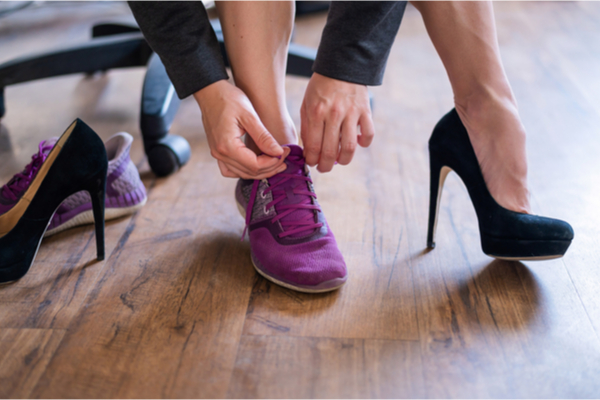Like any new habit, it can be hard to get into the groove of taking that midday break to exercise if it isn’t something you’re used to doing. Here are some expert tips for giving it a try — and making it a healthy habit you can stick with.
Dress in your workout clothes.
Save yourself the extra task of having to change your clothes when workout time rolls around. That way you can simply get up from your desk and jump right into it. (Plus, if you’re already dressed for a workout, you’ll be less likely to skip it.)
Start small.
An hour break is way more daunting, and harder to commit to, than a 10-minute walk. Start with something manageable and work your way up to a longer workout once you establish a habit. Stretches at your desk or a walk around the block are great ways to dip your toes into making this a habit. Then move on to 5-minute workouts. Next, try a 10-minute walk or work out at home with a yoga mat. Finally, commit to 30 minutes a day.
Schedule it like a meeting.
Whether you plan to do a 5-minute stretch session or a longer walk around the neighborhood, set a calendar reminder. Putting it on your calendar will not only alert co-workers that you will be away from your desk so that last-minute meetings don’t pop up, but it will also be helpful to see it in your schedule so that you can mentally prepare to take a break and then remember to actually step away.
Know your goal.
If someone is looking to just get their body moving, walking on the treadmill (or) outdoors, the Stairmaster or bicycling can benefit the mind and body. If you want to strengthen your muscles and joints, pumping iron or even calisthenics can work multiple muscles and get joints moving so that they offer support during activities and even during prolonged positioning. If someone is looking for more mental stress management, low-impact movements or stretches along with breathing control is extremely beneficial for those in fast-paced environments as it can help offset the flurry of activities and balance the high energies during the work day.
Choose an activity that complements your workday.
Know what your work day has in store for you.Try to do something that can balance or unload the work stresses versus doing something that adds more stress into your day, like squeezing in that high-intensity cardio when you have to ‘run’ back to your desk to complete a project.This sustained high energy run-around can actually lead to injuries as you might be trying to do too much in your day. For most people, yoga and Pilates will work wonders.
If you don’t have time for a break, combine work and movement.
Going on a walk outside is great if you’re short on time but can take a work call without video.
Plan a nutritious lunch ahead of time.
You also need to nourish your system after the workout which means some planning in a post-exercise meal. To prevent yourself from jumping right back into work without eating, prep easy meals that you can grab and eat or easily assemble like pre-chopping veggies and lettuce for salads or making a big pot of soup on Sunday night that you can heat up during the week.
Photo Credit: Reshetnikov_art / Shutterstock.com
